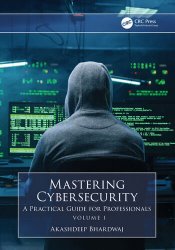Mastering Cybersecurity: A Practical Guide for Professionals (Volume 1)
- Добавил: literator
- Дата: 14-11-2024, 03:36
- Комментариев: 0
 Название: Mastering Cybersecurity: A Practical Guide for Professionals (Volume 1)
Название: Mastering Cybersecurity: A Practical Guide for Professionals (Volume 1)Автор: Akashdeep Bhardwaj
Издательство: CRC Press
Год: 2025
Страниц: 218
Язык: английский
Формат: pdf (true)
Размер: 50.1 MB
In today’s ever‑evolving digital landscape, cybersecurity professionals are in high demand. These books equip you with the knowledge and tools to become a master cyberdefender. The handbooks take you through the journey of ten essential aspects of practical learning and mastering cybersecurity aspects in the form of two volumes.
Volume 1: The first volume starts with the fundamentals and hands‑on of performing log analysis on Windows and Linux systems. You will then build your own virtual environment to hone your penetration testing skills. But defense isn’t just about identifying weaknesses; it’s about building secure applications from the ground up. The book teaches you how to leverage Docker and other technologies for application deployments and AppSec management. Next, we delve into information gathering of targets as well as vulnerability scanning of vulnerable OS and Apps running on Damm Vulnerable Web Application (DVWA), Metasploitable2, Kioptrix, and others. You’ll also learn live hunting for vulnerable devices and systems on the Internet.
Kali Linux is a popular distro with tools for security professionals and penetration testers. These tools empower pen testers to identify and exploit vulnerabilities effectively. However, it is crucial to emphasize that these tools are readily available, and malicious actors can also utilize them for nefarious purposes. These tools cover a wide range of categories. The various attack categories available in Kali Linux along with their descriptions and installed tools to perform different operations are as follows:
• Information gathering – collect and format the initial target data about systems and networks in a form that could be used in the future. Tools are NMAP, Zenmap, Stealth Scan, Dimitry, and Maltego.
• Web App analysis – identify weaknesses by accessing websites through browser-based tools to find bugs or loopholes leading to information or data loss. Tools are Skipfish, ZAP, Wpscan, SQLMap, HTTrack, Burpsuite, Vega, and Webscarap.
• Database assessment – access database to analyze for different attacks and security issues.
Tools are SQLMap, SQLNinja, Bbqsl, Jsql Injection, and Oscanner.
• Password cracking – handle the worklist or the password list to check against login credentials of different services, protocols, and hashes. Tools include Cewl, Crunch, Hashcat, John, Medusa, and Ncrack.
• Wireless attacks – assess and exploit wireless networks like Wifi routers and access points. These are useful not only for just SSID cracking but also for gathering information about user browsing behavior. Tools include Aircrack-NG, Kismet, Ghost Phisher, Wifilite, and Fern-Wifi-Cracker.
• Reverse engineering – helps break down the layers of applications by reaching into the source code to understand its working logic and data flow to manipulate as required. Tools include Nsam Shell, Flasm, Ollydbg, and Apktools.
• Exploitation tools – are frameworks that generate payloads that exploit known vulnerabilities in systems, apps, and services. Tools include Armitage, Metasploit, SearchSploit, Beef XSS, Termineter, and Social Engineering Toolkit.
• Sniffing and spoofing – secretly accessing data in an unauthorized manner, using fake profiles, and hiding real identity. Tools include Wireshark, Bettercap, Ettercap, Hamster, Driftnet, MACchanger, and Responder.
The two volumes will empower you to become a well‑rounded cybersecurity professional, prepared to defend against today’s ever‑increasing threats.
Contents:
Скачать Mastering Cybersecurity: A Practical Guide for Professionals (Volume 1)
[related-news] [/related-news]
Внимание
Уважаемый посетитель, Вы зашли на сайт как незарегистрированный пользователь.
Мы рекомендуем Вам зарегистрироваться либо войти на сайт под своим именем.
Уважаемый посетитель, Вы зашли на сайт как незарегистрированный пользователь.
Мы рекомендуем Вам зарегистрироваться либо войти на сайт под своим именем.

